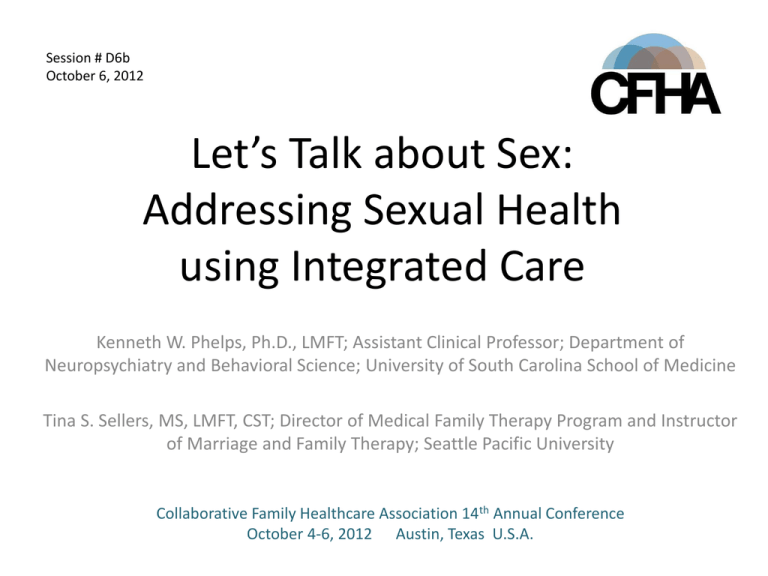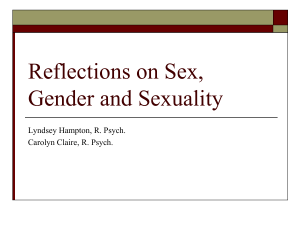
Session # D6b
October 6, 2012
Let’s Talk about Sex:
Addressing Sexual Health
using Integrated Care
Kenneth W. Phelps, Ph.D., LMFT; Assistant Clinical Professor; Department of
Neuropsychiatry and Behavioral Science; University of South Carolina School of Medicine
Tina S. Sellers, MS, LMFT, CST; Director of Medical Family Therapy Program and Instructor
of Marriage and Family Therapy; Seattle Pacific University
Collaborative Family Healthcare Association 14th Annual Conference
October 4-6, 2012 Austin, Texas U.S.A.
Faculty Disclosure
We have not had any relevant financial
relationships during the past 12 months.
Objectives
At the conclusion of the presentation, attendees
will be able to:
Identify common sexual dysfunctions that may present in
primary care.
Examine the advantages of integrated care in treating
sexual problems.
Consider the benefits of collaborative, biopsychosocial,
and systemic assessments.
Explore evidence-based treatments through a brief
overview and case example.
Learning Assessment Pre-test
How would you define sexual health?
What are the most common male and female sexual problems?
Name some core competencies of the integrated care team
treating sexual problems.
What are three interventions or treatments commonly used to
improve sexual health?
Questions…
• How important is sexual health to the QOL of your
patients? 1-10 (10 most important)
• How comfortable are your patients discussing their
sexual health? 1-10 (10 most comfortable)
• How comfortable are you discussing sexual health?
• Did you receive comprehensive sex education in
primary education or higher education? Yes or No.
• How often do you take a sexual history with patients
and under what conditions?
Defining Sexual Health
“State of physical, emotional, mental and social wellbeing in relation to sexuality; it is not merely the
absence of disease, dysfunction or infirmity. Sexual
health requires a positive and respectful approach to
sexuality and sexual relationships, as well as the
possibility of having pleasurable and safe sexual
experiences, free of coercion, discrimination, and
violence. For sexual health to be attained and
maintained, the sexual rights of all persons must be
respected, protected, and fulfilled.”
World Health Organization. Gender and human rights. http://www.who.int/reproductivehealth/
topics/gender_rights/sexual_health/en/index.html. Accessed August 15, 2012.
Defining Sexual Health
“Sexuality is an integral part of human life. It
carries the awesome power to create new life. It
can foster intimacy and bonding as well as
shared pleasure in our relationships. Sexual
health is inextricably bound to both physical and
mental health.”
Satcher, D. (2001). The Surgeon General’s Call to Action to Promote Sexual Health and
Responsible Sexual Behavior. http://www.surgeon general.gov/library/calls/sexualhealth/call.pdf.
A Biopsychosocial Picture
BIOLOGICAL
Biologic Sex
Hormones
Puberty & Menopause
Function / Dysfunction
Response Cycle
PSYCHOLOGAL
Subjective Sense of Self
Mental Health
Temperament
Attachment
Fantasy
SOCIAL
Intimate Relationships
Social Supports
Patient-Provider
Religion / Spirituality
Cultural Messages
Prevalence of Sexual Problems
Women
Low Desire
Inhibited Orgasm
Sex Not Pleasurable
Pain with Intercourse
Performance Anxiety
Lubrication Problems
Climax Too Soon
33.4%
24.1%
21.2%
14.4%
11.5%
10.4%
10.3%
National Health and Social Life Survey (1994). N = 1,410, ages 19-59
Prevalence of Sexual Problems
Men
Premature Ejaculation
Performance Anxiety
Low Desire
Erectile Dysfunction
Ejaculatory Inhibition
Sex Not Pleasurable
Pain During Intercourse
28.5%
17.0%
15.8%
10.4%
8.3%
8.3%
3.0%
National Health and Social Life Survey (1994). N = 1,410, ages 19-59
Sexual Health in Primary Care
• Discrepancy between prevalence & disclosure
– Patient Barriers
• Concern for provider’s comfort
• Personal embarrassment or discomfort
– Provider Barriers
•
•
•
•
•
Lack of training or skills
Underestimation of prevalence
Constraints on time
Fear of Pandora’s box
Personal embarrassment or discomfort
Gott, Galena, Hinchliff, & Elford, 2004; Owens & Tepper, 2007; Foley & Wittmann, 2010; Association of
Reproductive Health Professionals. Sexual Health Fundamentals. www.arhp.org/factssheets.
Why Integrated Care?
• “Sexual health services should be incorporated into
primary care and integrated services should be
expanded…including recognition of sexual health
throughout the lifespan.” (p. 1006; JAMA 2010, Vol. 304, No.9)
• Integrated care because:
–
–
–
–
–
Multidisciplinary team-based approach
Medical, psychological, and relational expertise
Mutual learning between team members
Assist with time demands of assessment or treatment
PCP preference vs. referral for some
Delivery of Integrated Care
Considerations…
BH enters BEFORE Medical Provider
BH enters WITH Medical Provider
BH enters AFTER Medical Provider
When to assess sexual health?
Establishing Treatment, Related to Chief Complaint,
Annual Exam, Reason for Possible Non-adherence,
Education for Co-morbid Condition
Inclusion of Partner or Family Member?
Core Competencies
• Delivery of Patient and Family Centered Care
• Comprehensive Sex History Taken Annually
– Types of sex practices, number of partners, frequency of
acts, orientation, abuse, STIs, satisfaction, concerns, etc.
• Awareness of personal biases and implications for possible
counter-transference
• Appropriate inclusion of parents in sexual education plans or
processes for children and teenagers
• Ability to use basic assessment and treatment strategies,
medical, relational, and cognitive-behavioral
• Referral to sex therapist or sexual medicine expert for
complicated cases that exceed scope of practice
Key Conversations with Youth
1.
2.
3.
4.
The Body (Birth to Four)
What is Sex? (Four to Eight)
Expect Puberty (Eight to Twelve)
Safety, Responsibility, Pleasure, and Choice
(Twelve and Up)
Yes – 100 / 1 min
No – 1 / 100 min
Richardson, J., & Schuster, M. A. (2003) Everything you never wanted your kids to know about sex (but were afraid they’d ask:
The secrets to surviving your child’s sexual development from birth to the teens. New York: Three Rivers Press.
Foundational Knowledge: Sexual Response Cycle
Foundational Knowledge:
Reed’s Erotic Stimulus Pathway
Seduction
Sensation
Surrender
Reflection
Foundational Knowledge: Basson Model
http://www.arhp.org/publications-and-resources/clinical-fact-sheets/female-sexual-response
Starting the Conversation
• Start with normalization
– “I often ask my patients about…
• How their medical conditions are affecting them
sexually. What problems are you having?”
• If they are having any sexual problems – desire, arousal,
orgasm, pain. Are you having any difficulty?”
• How they are doing in their relationship(s)?”
• Basics of screening for sexual function:
– Are you currently involved in a sexual relationship?
– Are your sexual partners men, women, or both?
Starting the Conversation
Open ended icebreakers recommended by ARHP
–
–
–
–
–
–
–
Tell me about any sexual concern you would like to discuss.
How does the problem affect your life and relationship(s)?
How does the concern present?
Tell me (or us) about your last sexual experience.
How have you tried to manage the problem thus far?
What are your goals for your sexual health?
Tell me (or us) about the conversation you have had with
your partner so far about this problem.
Association of Reproductive Health Professionals. Sexual Health Fundamentals. www.arhp.org/factssheets.
Areas of Curiosity
• Desire: Low sexual desire, aversion, too much desire,
discrepancy between partners, change from previous
satisfying relationship
• Arousal: Difficulty obtaining erection, difficulty maintaining
erection, difficulty with lubrication
• Orgasmic: Inability to reach orgasm, premature ejaculation,
delayed ejaculation
• Pain: Vaginismus, dyspareunia, male pain problems
• Relationship: Level of satisfaction, communication problems
(criticism, defensiveness, stonewalling, contempt), match
between partner’s sexual preferences or skill set, intimate
partner violence, alternative lifestyles
Screening Instruments
•
•
•
•
•
•
•
•
Decreased Sexual Desire Screener (DSDS)
Female Sexual Function Index (FSFI)
Sexual Interest and Desire Inventory (SIDI)
Brief Hypoactive Sexual Desire Disorder Screener
Male Sexual Health Questionnaire (MSHQ)
Brief Profile of Female Sexual Function (B-PFSF)
Index of Sexual Satisfaction (ISS)
Among Others
Collaborative / Systemic Screening
• Scaling questions
– Faciliates collaboration between patient, partner
or family, and providers
– Scale motivation, concern, worry over problem, or
the difficulty (hardness of erection, degree of
pain, amount of lubrication, etc.)
• Search for BIO PSYCHO and SOCIAL elements
– BH ask about psychosocial components and
medical provider ask about biological, physical
components of problem
Foundational Counseling: PLISSIT
dramymarshsexologist.com
Sampling of Treatments
for Male Sexual Problems
•
•
•
•
•
•
•
•
•
•
•
Psychoeducation
Stop-Start Method
Mindfulness and Relaxation Techniques
Sensate Focus with Partner
CBT for Cognitive Restructuring
Decrease Spectatoring
Use of Erotic Material
Vacuum Pump
Phosphodiesterase Type 5 Inhibitors
Relational or Sex Therapy
Identification and Communication of Preferences
Sampling of Treatments
for Female Sexual Problems
•
•
•
•
•
•
•
•
•
•
•
•
Psychoeducation
Information on Lubricants
Mirror for Self-Exploration
Vaginal Hygiene Recommendations
Appropriate use of Kegel Exercises
Mindfulness and Relaxation Techniques
Use of Erotic Material
Sensate Focus with Partner
CBT for Cognitive Restructuring
Pelvic Floor Physical Therapy
Relational or Sex Therapy
Identification and Communication of Preferences
Clinical Case
• 50 y/o AA male presents with complaint of
erectile dysfunction to his Integrated Care Team.
– Can obtain an erection at hardness of 4, but loses within a
few minutes
– Started on SSRI Zoloft for depression/anxiety approximately 2
months ago
– Comorbid type 2 diabetes - last HbA1c of 12.4
– Some relational conflict with wife and work stress
– Drinks 2-3 beers per evening
– Able to obtain erection at hardness of 6-7 when
masturbating and can ejaculate
Clinical Case
• 26 y/o Caucasian female presents with complaint
of pain with intercourse.
– No comorbid medical conditions
– Takes Yaz birth control
– Currently has one partner – sexually active for 2 months,
describes relationship as healthy
– Some difficulty with lubrication, but has not tried any products,
thinking of using Vaseline
– Describes many negative messages about sex from family of
origin (e.g. “dirty” “don’t talk about”)
Resources
• American Association of Sexuality Educators, Counselors, and Therapists
(AASECT), www.aasect.org,Search for certified sex educators or therapists
• Society for the Scientific Study of Sexuality (SSSS), http://www.sexscience.org,
Research on sexual education and health
• Association for Reproductive Health Professionals, http://www.arhp.org/
publications-and-resources/clinical-fact-sheets, Clinical fact sheets
• Sex Smart Films, http://www.sexsmartfilms.com, Sex education and health videos
• A Woman’s Touch, http://a-womans-touch.com, Education, resources, and info
about co-morbid medical illness
• Joy of Making Love, http://www.joyofmakinglove.com/index.html, Book
recommendations
Further Questions…
Session Evaluation
Please complete and return the
evaluation form to the classroom monitor
before leaving this session.
Thank you!









